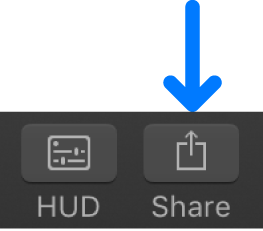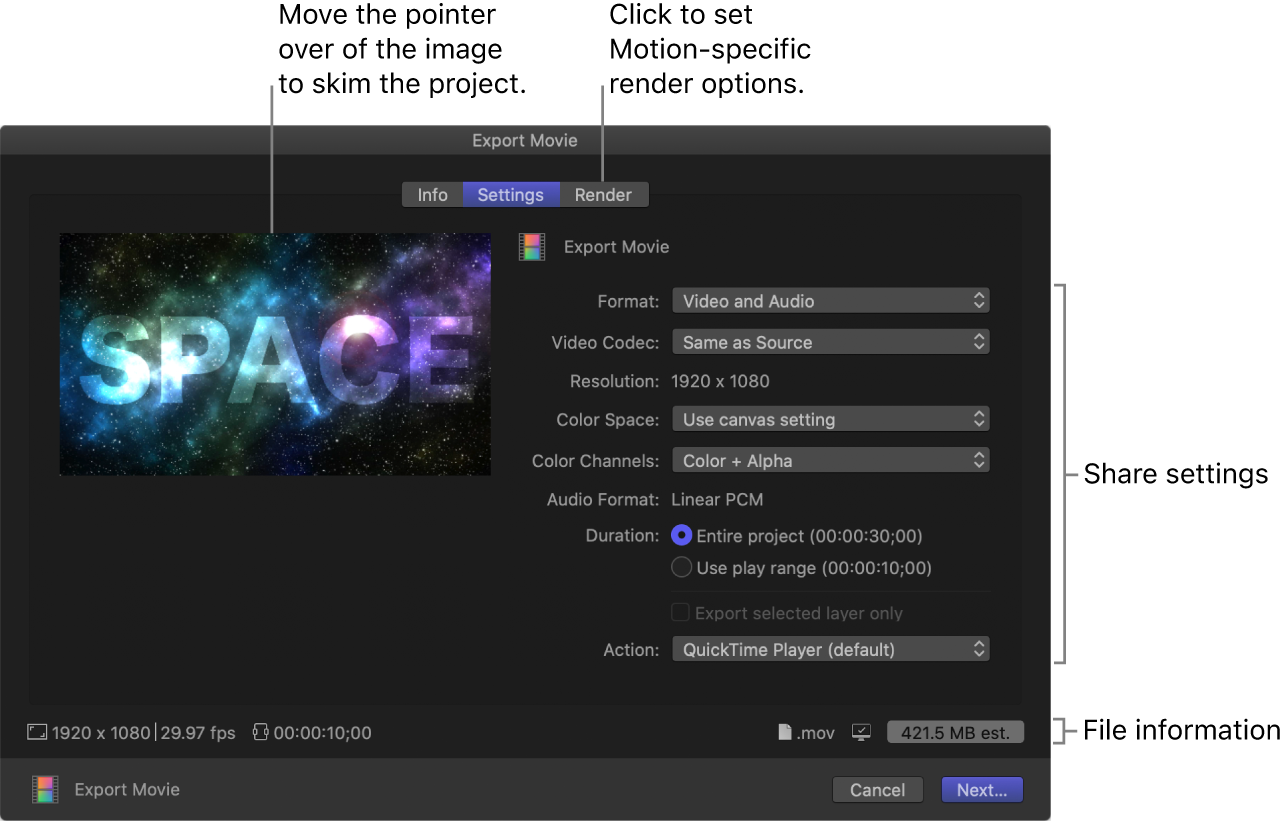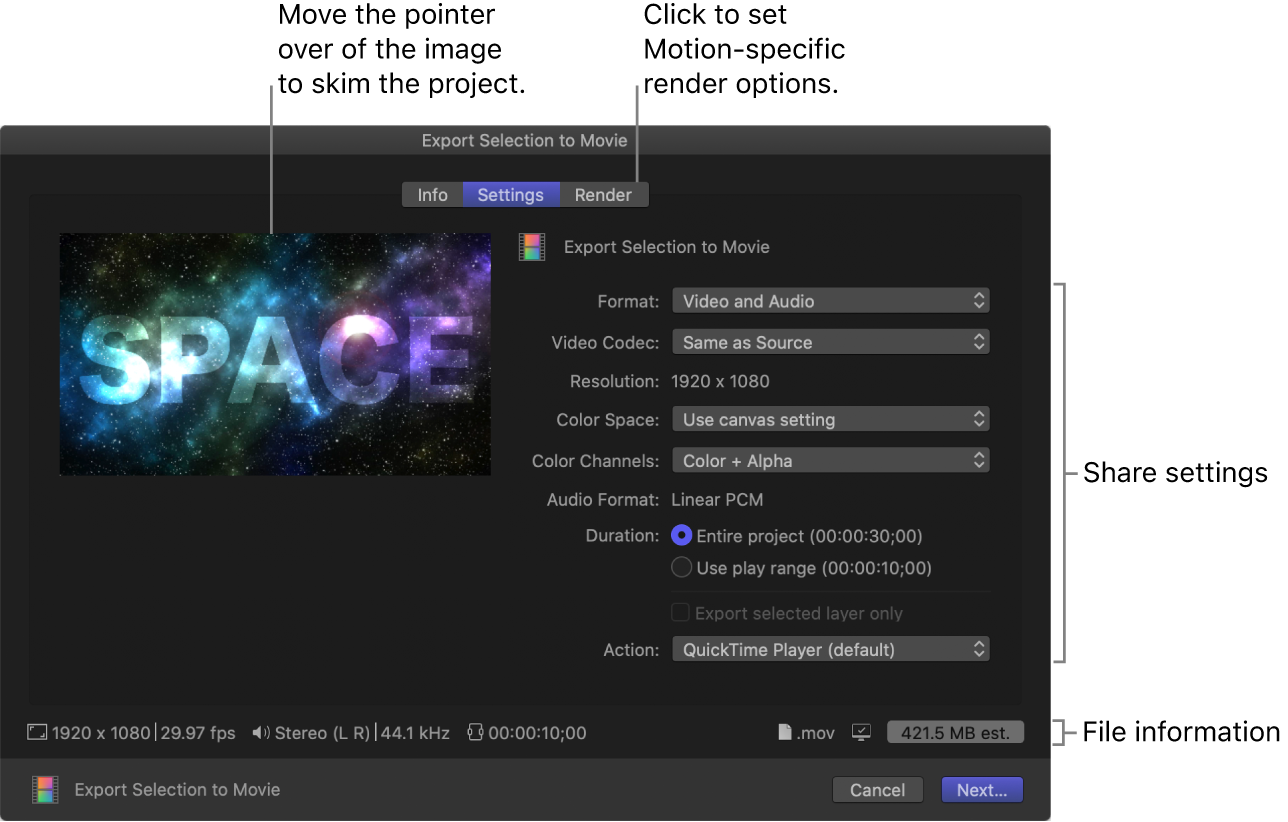Motion User Guide
- Welcome
- What’s new
-
- Intro to basic compositing
-
- Intro to transforming layers
-
- Intro to transforming layers in the canvas
- Transform layer properties in the canvas
- Transform tools
- Change layer position, scale, or rotation
- Move a layer’s anchor point
- Add a drop shadow to a layer
- Distort or shear a layer
- Crop a layer
- Modify shape or mask points
- Transform text glyphs and other object attributes
- Align layers in the canvas
- Transform layers in the HUD
- Transform 2D layers in 3D space
-
- Intro to behaviors
- Behaviors versus keyframes
-
- Intro to behavior types
-
- Intro to Parameter behaviors
- Audio behavior
- Average behavior
- Clamp behavior
- Custom behavior
- Add a Custom behavior
- Exponential behavior
- Link behavior
- Logarithmic behavior
- MIDI behavior
- Add a MIDI behavior
- Negate behavior
- Oscillate behavior
- Create a decaying oscillation
- Overshoot behavior
- Quantize behavior
- Ramp behavior
- Randomize behavior
- Rate behavior
- Reverse behavior
- Stop behavior
- Track behavior
- Wriggle behavior
-
- Intro to Simulation behaviors
- Align to Motion behavior
- Attracted To behavior
- Attractor behavior
- Drag behavior
- Drift Attracted To behavior
- Drift Attractor behavior
- Edge Collision behavior
- Gravity behavior
- Orbit Around behavior
- Random Motion behavior
- Repel behavior
- Repel From behavior
- Rotational Drag behavior
- Spring behavior
- Vortex behavior
- Wind behavior
- Additional behaviors
-
- Intro to using generators
- Add a generator
-
- Intro to image generators
- Caustics generator
- Cellular generator
- Checkerboard generator
- Clouds generator
- Color Solid generator
- Concentric Polka Dots generator
- Concentric Shapes generator
- Gradient generator
- Grid generator
- Japanese Pattern generator
- Lens Flare generator
- Manga Lines generator
- Membrane generator
- Noise generator
- One Color Ray generator
- Op Art 1 generator
- Op Art 2 generator
- Op Art 3 generator
- Overlapping Circles generator
- Radial Bars generator
- Soft Gradient generator
- Spirals generator
- Spiral Drawing generator
- Use Spiral Drawing onscreen controls
- Star generator
- Stripes generator
- Sunburst generator
- Truchet Tiles generator
- Two Color Ray generator
- Save a custom generator
-
- Intro to filters
- Browse and preview filters
- Apply or remove filters
-
- Intro to filter types
-
- Intro to Color filters
- Brightness filter
- Channel Mixer filter
- Color Adjustments filter
- Color Balance filter
- Example: Color-balance two layers
- Color Curves filter
- Use the Color Curves filter
- Color Reduce filter
- Color Wheels filter
- Use the Color Wheels filter
- Colorize filter
- Contrast filter
- Custom LUT filter
- Use the Custom LUT filter
- Gamma filter
- Gradient Colorize filter
- HDR Tools filter
- Hue/Saturation filter
- Hue/Saturation Curves filter
- Use the Hue/Saturation Curves filter
- Levels filter
- Negative filter
- OpenEXR Tone Map filter
- Sepia filter
- Threshold filter
- Tint filter
-
- Intro to Distortion filters
- Black Hole filter
- Bulge filter
- Bump Map filter
- Disc Warp filter
- Droplet filter
- Earthquake filter
- Fisheye filter
- Flop filter
- Fun House filter
- Glass Block filter
- Glass Distortion
- Insect Eye filter
- Mirror filter
- Page Curl filter
- Poke filter
- Polar filter
- Refraction filter
- Ring Lens filter
- Ripple filter
- Scrape filter
- Sliced Scale filter
- Use the Sliced Scale filter
- Sphere filter
- Starburst filter
- Stripes filter
- Target filter
- Tiny Planet filter
- Twirl filter
- Underwater filter
- Wave filter
-
- Intro to Stylize filters
- Add Noise filter
- Bad Film filter
- Bad TV filter
- Circle Screen filter
- Circles filter
- Color Emboss filter
- Comic filter
- Crystallize filter
- Edges filter
- Extrude filter
- Fill filter
- Halftone filter
- Hatched Screen filter
- Highpass filter
- Indent filter
- Line Art filter
- Line Screen filter
- MinMax filter
- Noise Dissolve filter
- Pixellate filter
- Posterize filter
- Relief filter
- Slit Scan filter
- Slit Tunnel filter
- Texture Screen filter
- Vignette filter
- Wavy Screen filter
- About filters and color processing
- Publish filter controls to Final Cut Pro
- Using filters on alpha channels
- Filter performance
- Save custom filters
-
- Intro to 360-degree video
- 360-degree projects
- Create 360-degree projects
- Add 360-degree video to a project
- Create a tiny planet effect
- Reorient 360-degree media
- Creating 360-degree templates for Final Cut Pro
- 360-degree-aware filters and generators
- Export and share 360-degree projects
- Guidelines for better 360-degree projects
-
- Intro to settings and shortcuts
-
- Intro to Keyboard shortcuts
- Use function keys
- General keyboard shortcuts
- Audio list keyboard shortcuts
-
- Tools keyboard shortcuts
- Transform tool keyboard shortcuts
- Select/Transform tool keyboard shortcuts
- Crop tool keyboard shortcuts
- Edit Points tool keyboard shortcuts
- Edit shape tools keyboard shortcuts
- Pan and Zoom tools keyboard shortcuts
- Shape tools keyboard shortcuts
- Bezier tool keyboard shortcuts
- B-Spline tool keyboard shortcuts
- Paint Stroke tool keyboard shortcuts
- Text tool keyboard shortcuts
- Shape mask tools keyboard shortcuts
- Bezier Mask tool keyboard shortcuts
- B-Spline Mask tool keyboard shortcuts
- Transport control keyboard shortcuts
- View option keyboard shortcuts
- HUD keyboard shortcuts
- Inspector keyboard shortcuts
- Keyframe Editor keyboard shortcuts
- Layers keyboard shortcuts
- Library keyboard shortcuts
- Media list keyboard shortcuts
- Timeline keyboard shortcuts
- Keyframing keyboard shortcuts
- Shape and Mask keyboard shortcuts
- 3D keyboard shortcuts
- Miscellaneous keyboard shortcuts
- Touch Bar shortcuts
- Move assets to another computer
- Work with GPUs
- Glossary
- Copyright and trademarks

Export a QuickTime movie in Motion
Export your project as a QuickTime movie file when you want to:
Use the movie file in another Apple application, such as GarageBand, Pages, or Keynote; or when you want to use it in a third-party application
Copy the movie file to an external storage device or post it to a server for a client to review
Post the movie file on social media
Note: You can also export your Motion 360° projects for posting on YouTube’s Virtual Reality channel or Vimeo 360. See Export and share 360° projects.
Share your project as a movie file
In Motion, do one of the following:
Choose File > Share > Export Movie (or press Command-E).
On the right side of the toolbar, click Share, then choose Export Movie.

In the Info pane of the Export Movie window, view or modify project attributes, such as the title and description.
In the Settings pane of the Export Movie window, choose your preferred export settings:

Format: Choose whether to export video and audio, video only, or audio only.
You can also select a publishing format, including Apple Devices (such as iPhone and iPad), Computer (for playback on Mac and PC), or Social Platforms (such as YouTube or Vimeo). Your choice of format determines the options in the pop-up menus below.
Video Codec: The source codec is chosen by default, but you may choose another codec.
Resolution: The default frame size, defined by the Project Properties.
Color Space: Choose the range of color used in the exported movie. The default option (“Use canvas setting”) applies your project’s color space, but you can choose a different color space. See About color space.
Color Channels: Choose whether to output color channels (RGB) only, alpha channels (transparency), or color channels plus an alpha channel.
Note: Not all codecs support an embedded alpha channel. For codecs that don’t support an alpha channel, no alpha channel is saved, regardless of the option you choose in this pop-up menu.
Audio Format: The audio format is chosen by default based on the selected video codec. (To choose another audio format, you must choose Audio Only from the Format pop-up menu, which then only exports the project’s audio.)
Duration: Select whether to export the entire project or a portion of the project (play range).
Export selected layer only: Select to export only the layer that’s currently selected in the project. If no image layer is selected, or if an object that does not render is selected (such as a rig, a light, or a camera), this option is dimmed.
Action: Choose what you want to happen after the export is complete. See Export File destination.
You must have the Compressor app installed on your system to open your export in Compressor.
Note: If you change the destination’s settings, the changes are saved as the default settings for the destination. See Create and modify share destinations.
In the Render pane of the Export Movie window, choose your Motion-specific options, such as Motion Blur, Frame Blending, or Shadows.
For a description of each setting in the Render pane, see Render settings.
Click Next.
Enter a name and choose a save location for the exported file, then click Save.
Share a selected object from your project as a movie file
Export a complex layer or animated object to quickly review a single element in your project, to simplify a project, or to improve playback performance.
In Motion, select an object in the Layers list or Timeline, then do one of the following:
Choose File > Share > Export Selection to Movie (or press Option-Command-E).
On the right side of the toolbar, click Share, then choose Export Selection to Movie.

Note: If an object that does not render is selected (such as a rig, a light, or a camera), the Export Selection to Movie option is not available.
In the Info pane of the Export Selection to Movie window, view or modify project attributes, such as the title and description.
In the Settings pane of the Export Selection to Movie window, choose your preferred export settings:

Format: Choose whether to export video and audio, video only, or audio only.
You can also select a publishing format, including Apple Devices (such as iPhone and iPad), Computer (for playback on Mac and PC), or Social Platforms (such as YouTube or Vimeo). Your choice of format determines the options in the pop-up menus below.
Video Codec: The source codec is chosen by default, but you may choose another codec.
Resolution: The default frame size, defined by the Project Properties.
Color Space: Choose the range of color used in the exported movie. The default option (“Use canvas setting”) applies your project’s color space, but you can choose a different color space. See About color space.
Color Channels: Choose whether to output color channels (RGB) only, alpha channels (transparency), or color channels plus an alpha channel.
Note: Not all codecs support an embedded alpha channel. For codecs that don’t support an alpha channel, no alpha channel is saved, regardless of the option you choose in this pop-up menu.
Audio Format: The audio format is chosen by default based on the selected video codec. (To choose another audio format, you must choose Audio Only from the Format pop-up menu, which then only exports the project’s audio.)
Duration: Select whether to export the entire project or a portion of the project (play range).
Export selected layer only: Leave this checkbox selected to export only the object selected in the project.
Action: Choose what you want to happen after the export is complete. See Export File destination.
Note: If you change the destination’s settings, the changes are saved as the default settings for the destination. See Create and modify share destinations.
In the Render pane of the Export Selection to Movie window, choose your Motion-specific options, such as Motion Blur, Frame Blending, or Shadows.
For a description of each setting in the Render pane, see Render settings.
Click Next.
Enter a name and choose a save location for the exported file, then click Save.
You can monitor the progress of your export in the Background Task List, and you can continue to work in Motion while the file is rendered.
When exporting is complete, a notification appears. Click the notification to display the shared file in the Finder.
Tip: When you export your project, the audio is exported according to your computer’s current audio settings. You can change the exported audio sample rate using the Audio MIDI Setup application in macOS. To do so, quit Motion, then in the Finder, choose Go > Utilities and open the Audio MIDI Setup application. In the Output pane, specify a new sample rate. When you reopen Motion, although the chosen sample rate is not displayed in the Motion share dialog, your project is exported with the sample rate set in the Audio MIDI Setup application.
Download this guide: PDF